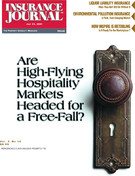If the hospitality market has firmed recently to, say, the consistency of crème brulée, will it necessarily become more like peanut brittle in the coming months? Who knows? But like many areas of today’s economy, including most insurance markets, the hospitality environment is feeling its share of the downturn, with rates going up and coverage becoming harder to find.
Restaurants, hotels and motels are among the businesses that fall into the hospitality category. In Texas, going out to eat and staying in rooms that rent by the night have in no way lost their appeal, according to statistics compiled by such sources as the Texas Department of Economic Development (TDED), the Texas Restaurant Association (TRA) and Restaurant Business Magazine. But those industries are experiencing slowing growth rates. And with carriers tightening underwriting requirements, raising rates, and in some cases, pulling out of the market altogether, the market may not be grounded just yet, but the heady days of easy coverage and low pricing seem to be lost for now.
The Hard Facts of Hotel/Motel Cover
“Hard: not easily penetrated; not easily yielding to pressure. Firm. Definite. Oppressive. Tough. Strict”. Those are just a few of the words Miriam Webster’s Collegiate Dictionary uses to describe the meaning of the word “hard.” According to some insurance professionals, those words clearly paint a picture of the hotel/motel insurance market in Texas these days.
Becky Thompson, associate vice president of property and casualty with Austin Surplus Lines, summed the hospitality market up this way: “Hard. Pricing is up and standard markets are not writing (policies). The hotel/motel business is extremely hard.”
Glenn McKelvey, a producer with the FD&S Insurance Agency in Tyler, agreed. “In the past four to six months we’ve seen a drastic upward swing on renewals,” McKelvey said, adding that part of the problem is that people are used to seeing renewals lower than they were the year before. He said 25 percent increases are a good deal right now, with renewal rates going up from there, and noted that those who have grown accustomed to really low prices “will be the hardest hit.”
In the opinion of Jim Thomas, a vice president of U.S. Risk in Dallas, the “hospitality markets are pretty much doing what everything else is doing – rates are going up and a lot of carriers are getting out.” However, Thomas said, “there are very few classes of business that you can’t underwrite for a profit – it’s a matter of pricing.”
Data collected by TDED show that as of the end of the first quarter of this year, Texas had 3,430 hotels and motels in operation, and 304,300 rooms available. Hotel/motel revenues for the quarter peaked at nearly $1.2 billion, a 6.1 percent increase over the same period last year.
Although such an increase is nothing to sneeze at in a $1 billion-plus industry, TDED figures also indicate that the rate of growth has dropped, compared with the last few years. In 2000, the state experienced a 9.9 percent increase in lodging room revenues, plus 6 percent in 1999, plus 10.6 percent in 1998 and plus 9.7 percent in 1997.
Despite the slowing rate of revenue growth in the lodging industry, Texas is still very much in demand as a tourist and business travel destination. During third quarter 2000, visitors made 45 million trips in the state. While the total person-trips declined by 2 percent over the same period in the previous year, business travel grew by 14 percent during the quarter, from 14 million trips to 16 million. And the share of visitors staying in hotels and motels grew to 43 percent, an eight-point increase over third quarter 1999. TDED reported that the growth spanned across all hotel levels, from budget to luxury, and was similar to growth levels experienced nationally.
McKelvey, whose agency is endorsed by the Texas Hotel & Motel Association for its property programs, said he has seen a lot of smaller hotels being built in the past few years. Properties with 40 to 60 units, as opposed to 100 units, are gaining ground. They are attractive to property owners and insurers alike because they are easier to maintain and easier to fill than larger hotels, said McKelvey.
According to Thompson, one reason property insurance on hotels and motels so difficult is that lodging establishments have a lot of property value in one place. Hotels, especially, are at risk because they usually consist of a big building with a large roof. “Wind and hail risks are driving the market in Texas,” Thompson said, “especially in Dallas, Fort Worth and Houston since they have huge roof exposures to wind and hail. Too much exposure. Underwriters are finding that it’s easier to just get out of the market altogether than to just get out of a certain territory.”
Albert Carrillo, a program underwriter with Swett & Crawford operations in Los Angeles, agreed with Thompson’s assessment. He specializes in property insurance programs for full service, three-star hotels, boutique hotels and full-service bed-and-breakfast establishments. Carrillo said he’s “seeing a lot of business from Texas now because of recent catastrophes – floods, tornadoes – business that used to go to companies like Zurich. Texas will really have difficulty after they get the full numbers from the flood that just occurred,” said Carrillo.
Thompson said general liability rates are based on sales. Outside of Houston, Austin and the Orange-Beaumont-Port Arthur areas, rates are around $7/$1000 in sales for $1 million limits. In the Houston area, rates are closer to $14 or $15/$1000 in sales.
There are a lot of variables involved in property insurance, including whether or not sprinklers are installed, the number of stories, condition of the property and location, Thompson said. Property rates generally start around $0.50 per $100 of insured value. For a hotel valued at $1 million the rates run in the $5,500 – $8,500 per year range. Outside of the high-density areas of Houston, Dallas and Fort Worth, the rates are somewhat lower. “In higher risk areas, companies are using higher wind deductibles to lower premium costs,” Thompson said. “For instance, there might be a $1,000 deductible for all perils, but a $5,000 deductible for wind.”
When considering applications, carriers require prior carrier information, a loss history of three to five years (with five being better) and complete applications. Variables likely to be given serious consideration are swimming pools – including gates, safety features, and chemicals used – as well as receipts, construction, age of a building and the updates to it, and roofs. The age of the roof, the kind of roof, and roof replacement costs will all be examined, and many companies will not offer replacement coverage for a roof if it is over 10 years old.
Thompson said that for older properties, carriers are less willing to pay for more than the property is worth. “ACV (actual cash value) is back in vogue,” she said, defining ACV as policy replacement cost less depreciation. “Customers aren’t used to that since they have been getting so much more coverage in recent years.”
While coverage may be more difficult to find, it’s not impossible. McKelvey said he primarily turns to U.S. Fidelity and Guaranty. Although he used to write with Westchester and Legion, McKelvey uses them less often now. Carrillo teams up with United National for general liability and Deana Crowson, with Swett & Crawford in Dallas, said The St. Paul Companies and Scottsdale Casualty are still in the mix.
National Specialty Underwriters (NSU) in Bellvue, Wash., specia lizes in programs for the hotel industry nationwide. Company spokesman Rich Hancock said the company “is unique in what we do. Aside from our medical malpractice side, we focus directly on hotels. There are other companies that offer hospitality programs, but none that focus 100 percent on hotels,” said Hancock.
NSU offers several programs for hotels based on their classification as budget, middle market or luxury lodging. The Limited Service Program caters to the economy/budget hotel market, the Select Program covers the middle market and the Premier Program provides coverage for luxury hotels.
Catering to economy hotels that usually don’t have restaurants, the Limited Service Program is anchored by a business owners’ policy written exclusively by The St. Paul Companies. It includes coverage for general liability, property, boiler and machinery, and crime. Business auto liability is available on a separate policy. The limit for general liability coverage is $1 million, and an optional umbrella policy that provides up to $10 million in limits.
NSU’s Select Program is geared toward the largest segment of the lodging industry – hotels with rooms that run $40 to $100 per night. The company said it is an effective program for hotels that have a restaurant and more than 100 rooms. The program provides umbrella limits up to $250 million, with a minimum primary account premium of $25,000.
The Premier Program for luxury hotels, hotel casinos and destination resorts, caters to properties accustomed to buying in excess of $25 million in liability limits and assuming some risk through a self insured retention. It offers a liability limit of up to $300 million. Policy premiums are based on the number of guestrooms.
Is There a Recipe for Restaurant Insurance?
According to Restaurant Business Magazine, as of October 2000 there were 38,766 restaurant “units” in Texas. The TRA has estimated that restaurant sales in the state will reach nearly $26.4 billion in 2001, a 7 percent increase over the previous year. No matter how you look at it, those numbers represent a lot of meatballs, steak, veggie burgers, breakfast tacos, and so on. And a lot of bread – as in dollars.
While the market for hospitality insurance has hardened from the easy-going hoopla of previous years, those numbers could represent an opportunity to make money in a still growing industry. According to Jim Thomas, a vice president with Dallas-based U.S. Risk, “there aren’t too many risks that you can’t give out a number for that you can’t make money on.” He added that if you write a policy properly it should be acceptable to both the client and the carrier.
“The standard markets have gotten out of the restaurant business or have cut back on writing policies, so that business is being pushed down to the excess and surplus lines. People who are writing policies are more selective about what they write and prices are higher,” Thomas said.
He said that there is no one reason underwriters are pulling out, but noted that “rates were too cheap for too long – something has to give.” Thomas said that a renewal rate of 25 percent over last year is a great price, adding that 30, 40, and 50 percent increases on renewals is not unusual. “As we get further into the hardening market, I anticipate prices getting more strange. The standard markets will pull back even more….They will reach a point where they don’t have to write any more business and rates will go higher,” Thomas said. He indicated that restaurants should not be affected as badly as nightclubs.
Glen Gary, general counsel for the TRA, advises association members on a variety of general legal issues, including insurance. In addition to general liability, he urges restaurant owners to consider a number of policy add-ons when contemplating insurance purchases and recommends evaluating those enhancements according to the particular needs of a business. For instance, Gary said, if a restaurant provides its own valet service, they should consider garage liability insurance, but if contractors are hired to provide the service, the restaurant should make sure the contractors have their own insurance.
Gary also counsels owners to take a close look at insurance for business interruptions. He said many business owners don’t think about purchasing that type of insurance, but it’s useful in case of fire damage or other circumstances that force a restaurant to shut down for any period of time. “And it’s usually not terribly expensive,” Gary said. Other areas that he recommends restaurant owners consider carefully are employee practices and workers’ compensation insurance.
Thomas said one problem with restaurants, from an insurance standpoint, is that the mortality rate of restaurants is high. “Also there is a moral hazard issue – where someone gets into business and can’t make it and the business suddenly burns to the ground.” Thomas said. “Arson is often a problem in a bad business situation.”
Consequently, one of the things underwriters look at when evaluating a restaurant is the number of years the business has been in operation. The longer the better, and a restaurant that has been in business longer than 10 years is considered a good risk.
The history of a restaurant’s loss experience is also very important, Thomas said. If a business that has been plagued with frequent claims, especially if they are all the same types, it may indicate that the business is poorly managed.
Another red flag area is liquor liability – lawsuits are problematic and they drive up costs. Thomas said that it is difficult for an alcohol-serving establishment to defend itself. Especially tricky are cases in which a person comes into a restaurant or bar and has been drinking previously. Even if that person was already drunk to begin with, if he leaves your place and gets into an accident, it can be a big problem for the restaurant, Thomas said. He added that “laws vary from state to state, but even if the guy was not legally drunk….the police can make the call and decide alcohol is a factor.” And they can go after the last place that person visited.
So, for restaurants serving alcohol, underwriters are interested in whether the servers are Texas Alcohol Board of Control (TABC)-certified or if they have gone through some similar alcohol service training.
Other areas underwriters consider are the cooking facilities. Among the things they will be looking at is whether or not extinguishing systems are installed above the cooking areas. Construction of the facilities will also be examined. The condition of the building and whether it is constructed of frame or concrete is important. Insurers are likely to look more favorably on concrete buildings because they won’t burn, Thomas said.
He said Scottsdale Casualty and the Zurich companies are markets he often relies on to write policies. Rates are usually based on yearly revenues, or receipts, and 99.9 percent of the time coverage is renewed annually. Premiums are usually paid up front, but Thomas said sometimes carriers help work out a financing deal through a financial entity. However, the carrier is still paid in advance of coverage.
Chip Shattuck, a senior property underwriter with Swett & Crawford, said he’s been placing policies with The St. Paul Companies and Lloyd’s of London. Shattuck has been seeing rates of around $0.80 per $100 of coverage on the property side. In his experience, rates for general liability have gone up a little, but nothing like those for property insurance. “We’re still seeing the upswing in a tight market,” Shattuck said, “and restaurants have been swept along with other classes, like apartments and retail operations in general.”
We’re “coming off years of too cheap rates and less ratios,” Thomas said, “and it’s easier for underwriters to say that the market is bad, that they can’t make money, than to admit that they made mistakes in their underwriting. For 15 years of a soft market, people have been doing cash-flow underwriting just to get premium on the books,” he added, “without looking closely enough at the risks.”
For hotels, motels and restaurants, now is the time to change all that. Look at the risks, look at the history, look at the potential and write accordingly.
Topics USA Carriers Texas Excess Surplus Underwriting Property
Was this article valuable?
Here are more articles you may enjoy.


 ‘Door Knocker’ Roofers Were Everywhere. NC Farm Bureau Saw an Opportunity
‘Door Knocker’ Roofers Were Everywhere. NC Farm Bureau Saw an Opportunity  State Insurance Legislators ‘Greatly Disturbed’ by Trump AI Regulation Order
State Insurance Legislators ‘Greatly Disturbed’ by Trump AI Regulation Order  McKinsey Plots Thousands of Job Cuts in Slowdown for Consulting Industry
McKinsey Plots Thousands of Job Cuts in Slowdown for Consulting Industry  North Carolina Sting Operation Alleges Roofer Damaged Shingles to File Claim
North Carolina Sting Operation Alleges Roofer Damaged Shingles to File Claim 


